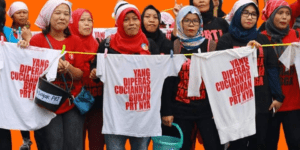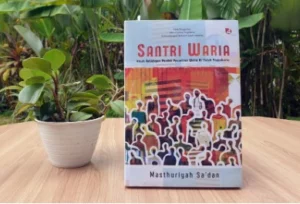Have you ever thought, who sews your clothes every day? Who put the buttons on? Who washes and packs them so that they become clothes that you are ready to wear?
This question bothers me a lot. Many women work behind the clothes we wear, but their names are never written. They are behind a row of clothes on display in malls or shopping centers. However, their efforts are incalculable. Their hard work is often not recorded, they also work tirelessly amid the noise of factory machines every day.
Those who work on the clothes that we wear are garment workers whose workers are mostly women. Want to know what problems befell them? Research conducted by Women Mahardhika on female workers in the Bonded Nusantara (KBN) factory area of Cakung, Jakarta in 2017 found that 50% of them expressed fear or worry when they found out that they were pregnant, due to an unfriendly work environment for pregnant workers.
What are the problems faced by women garment workers?
1. Uneasy Pregnancy
For pregnant workers, insecurity arises when the work that is their source – of life is in a space of uncertainty. It is uncertain whether the work continues, or the results of the work are not sufficient and guarantee the welfare of the mother worker. It becomes increasingly unsafe when the work turns out to increase the threat to the health and safety of the worker’s fetus.
Worries and fears are a form of insecurity for women garment workers who are pregnant, towards the things they are currently facing, or the uncertainty about the future of the workers and the fetus they are carrying.
Researcher and National Secretary of Mahardhika Women, Mutiara Ika once mentioned that there are many factors cause them to feel worried, and this is what prompted Mahardhika Women to conduct a study on the working conditions of women garment workers related to their pregnancy.
A total of 59 (50%) female workers who are currently or who have been pregnant expressed fear of having a miscarriage while working. Pregnant workers should get some convenience and relief in their work, especially from activities or situations that can harm on the health of the mother and fetus. However, the results of this study found that the majority (60%) of workers who were and have ever been pregnant did not notice any changes in their daily workload, meaning that the workload and targets remained the same as other workers who were not pregnant.
2. Fear of Losing Job
The fact that most of the garment workers at KBN Cakung are contract workers has an impact on the high uncertainty (and future) of workers’ work. For these contract workers, answering questions about their future work in the company (now) is very difficult or almost impossible. There are 177 (22.9%) female workers who have worked at KBN Cakung for more than 10 years but still have contract status.
In the shackles of unclear status (contracts), these workers certainly try everything they can to still be able to work and to earn income. This study found a phenomenon of concealing pregnancy among some female workers.
3. Vulnerable to Miscarriage
The high workload and the uncooperative attitude of supervisors increase the vulnerability of pregnant workers, which can lead to miscarriage. The results of the study found that seven (7) workers who miscarried while working and three (3) of seven (7) workers who miscarried did not get leave. The three workers are on contract status.
By the provisions of the law, a female worker who experiences a miscarriage is entitled to a break of 1.5 (one and a half) months following the health certificate issued. The good news is that several companies at KBN Cakung are even willing to give miscarriage leave equivalent to giving birth, which is for three (3) months. However, several other companies chose to ignore the leave rights.
4. Giving birth and being healthy, not necessarily safe
The results of this study found that 93 female workers gave birth between 2015 – 2017 while working in the Cakung KBN area, and the company concerned in 2017 was still operating.
Of the 86 respondents who gave birth safely, most (70 people or 79.6%) received maternity leave from the company by the provisions of the law. The remaining 20.4% (16 people) did not get maternity leave.
Although getting maternity leave by the provisions of the law, it does not fully guarantee the security of continuing to work if it is related to work status because 44 of the 86 respondents have contract status, which expires at any time and is not continued.
5. Difficult Access to Breastfeeding
The importance of exclusive breastfeeding for a baby certainly cannot be denied, even the government with various regulations states the importance of ensuring the opportunity for a baby to get exclusive breastfeeding, as well as the importance of protecting breastfeeding mothers. In this study, Mahardhika Women found the following facts:
No breastfeeding permit. Most of the respondents stated that there was no breastfeeding permit from the company (86%), which means that they can only breastfeed by taking advantage of the lunch break. Then also limited access to the lactation room. A total of 52.3% of female workers are aware of the existence of a lactation room in their factory and 47.7% are not aware of the existence of a lactation room in their factory. Of the 52.3% who know there are as many as 23.3% who use it.
From the results of the study, there are several recommendations put forward by Women Mahardhika as an effort to create a safe workspace for women, namely for the Government, to increase supervision of the implementation of the Manpower Act No. 13 of 2003, as well as carry out the function of supervision in the labor sector by increasing attention to maternity rights in the workplace, because there are still quite a lot of companies that have not complied and consistently carried out the things regulated in the UUK related to the protection of the maternity of women workers.
Then to create a more comprehensive legal basis in protecting the maternity rights of women workers, the Government is supported to ratify the ILO Convention number 183, 2000. Provisions on rest periods, health services, and benefits are indispensable for women workers to ensure the continuity and feasibility of their lives with their children.
(Photo/Illustration: Freepik.com)













